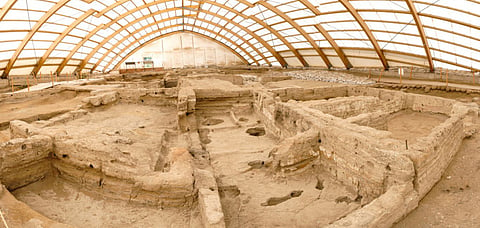
- Destinations
- Experiences
- Stay
- What's new
- Editor’s Picks
- Responsible Tourism
- CampaignsCampaigns
- Subscribe

Türkiye offers so many varied experiences that it is hard to pinpoint one that stands out. However, if I had to choose, it would be a visit to a 9,500-year-old Neolithic archaeological site called Çatalhöyük in the country's Central Anatolian region.
Türkiye has history oozing out of its soul, streets, mosques, ancient cities, and prehistoric sites, so it's only apt that it should be the home of one of the world's oldest cities.
In its heyday, between 7500 BC to 6400 BC, Çatalhöyük was a thriving urban community of around 8,000 people who lived in close proximity to each other in mudbrick homes that could only be accessed through openings in the roofs. The well-preserved UNESCO World Heritage site, which is said to have been continuously inhabited for almost 2,000 years, holds the key to understanding how human civilization developed from basic agrarian societies to planned urban settlements.
Excavations between 1961 and 1965 by British archaeologist James Mellaart uncovered this hidden city that had been built layer by layer over the ages, with the oldest dating back to 7100 BC. Fresh excavations were conducted in 1993 by a team led by the University of Cambridge's Ian Hodder.
It was my third day in Konya, and we had set off for Çatalhöyük on our tour bus guided by the cheerful and informed Mehmet Dönmez. Konya is one of Türkiye's largest cities and home to about 21.6 lakh people. It was once the home of Mevlana Jelaleddin Rumi, the 13th-century Sufi ascetic that the world loves and reveres, and it is where he lies entombed.
The chilly December morning started bright and sunny, but as we progressed towards Çatalhöyük, about 40 km away, a fog descended. Much of the journey through the Anatolian plains was shrouded in a haze, and I wasn't pleased that Delhi's notorious fog seemed to have followed me here.
However, as we neared our destination, the mist suddenly lifted, and brilliant sunlight washed the rolling fields and mounds where one of the world's most fascinating prehistoric sites stands.
The Çatalhöyük archaeological site, which predates our Indus Valley Civilization by a few thousand years, is divided into the East Mound and the West Mound, of which only the former is accessible to the public. On the East Mound, two shelters, the North and South Shelters, protect what is left of the ancient city. We made our way to the North Shelter as the other was under maintenance, which was a pity because the South Shelter houses the more ancient dwellings.
What struck me was how the one-room houses were packed together side by side with no space in between, almost like a warren, with one home leading into the other. The people of Çatalhöyük clearly had no option but to be good neighbors.
A signboard near one of the dwellings informed us that much of the city's daily life played out on the roofs, with people using them to go from one place to another, for leisure, and to do household chores when the weather was good. The living quarters were primarily used to sleep, cook, and bury their dead. Çatalhöyük residents liked to keep their ancestors close, and many excavated pits have uncovered well-preserved skeletons, some intact and others without skulls.
While the excavations found many artefacts in good condition like bone artefacts, tools, arrowheads, obsidian (smooth volcanic rock) pieces and fragments of textiles, most of them have been moved to the Museum of Anatolian Civilizations in Ankara.
One of the most famous finds excavated by Mellaart is the Seated Woman of Çatalhöyük, a nude female form in clay seated between armrests with feline heads. Said to be from 6000 BC, she is now placed at the Ankara Museum.
Some of the dwellings still have some remnants of wall paintings, but they are so faded that I could not decipher much.
On our way down the hill, Mehmet suddenly swooped down and picked up a shiny flat black rock from the volcanic soil. He was convinced that the shiny piece glinting in the sun was a remnant of a prehistoric obsidian artefact. I was sceptical but, who knows
From the evidence found so far, Çatalhöyük was a society of equals. All the houses are similar; no grand structures, temples, or public buildings point to a rigid social hierarchy or a central management system. Research also suggests that there was gender parity in terms of nutrition and division of labor. And as incredible as it may sound, there is also no evidence of battle or strife. So, while we cannot be sure if Çatalhöyük was a peaceful, idyllic paradise, its way of life does have some lessons for us.
You can fly to Konya Airport and then take a taxi or bus to the site. Alternatively, train or bus services from Istanbul to Konya are available, followed by a local journey to Çatalhöyük. Konya serves as a major hub for those driving, with clear directions leading to the archaeological site. Remember to plan your visit during the spring or autumn for comfortable weather and to check the site’s opening hours, which are typically daily except for Mondays.
